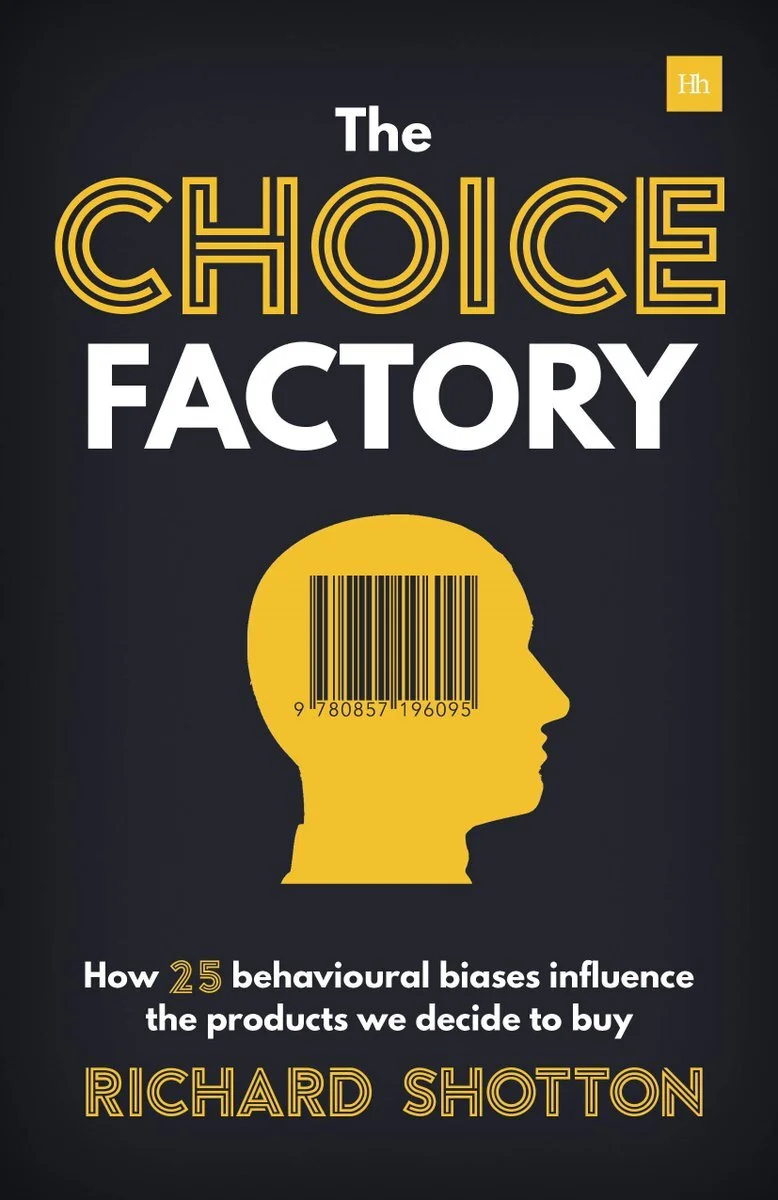Choice Factory by Richard Shotton | Book Summary
Title: The Choice Factory
Author: Richard Shotton
Genre: Behavioural Economics
Finished: March 2021
Published: 2004
🚀 The Book in 3 Sentences
We assume we are rational decision makers, but in fact there are many biases and heuristics that our mind uses to influence most of our decision making.
These heuristics can be leveraged by brands and marketers to achieve their objectives, whether that is for the benefit of the environment or selling goods and services.
Most of these biases are context-dependent and some even contradictory to one another, so it’s important when developing strategy and creative to understand which ones are relevant to the task at hand.
🎨 Impressions
A really fun book chock full of examples. Examples are so great, because they provide a lot more color and richness to the abstract world of heuristics. What I loved about Richard’s examples was that he selected cases from a wide variety of categories and scenarios, so his points never felt narrow or only relevant to a certain type of purchase or decision making occasion.
The last benefit of these examples is to hammer home his point that biases are very dependent on context. Where he can, he illustrates examples of where the opposite biases are taking place for the same effect. As he puts it: ‘match the bias to the task’.
For example:
The scarcity and social proof biases can both work to sell an experience.
If we employ scarcity in a romantic context, it will motivate people to seek out that experience. But social proof is more effective when a scary context has been established.
Results of an experiment showed that language like ‘unique’ (aka scarcity) was better employed to sell to people who had been primed romantically. Whereas a ‘popular’ experience (social proof) was better for the crowd that had been primed with horror or fear.
📚 Who Should Read It
Anyone in advertising, marketing, or anyone who has an interest in nudges, behavioural economics or how the human brain works.
☘️ How This Book Changed Me
It armed me with a load more practical examples for how biases and nudges work in marketing.
🕵️♂️ How I Discovered It
One of those books that has been in marketing circles since it came out.
✍️ My Top Three Quotes
“The conscious brain thinks it is the Oval Office, but in fact it is the press office.” - Jonathan Hait
“It took millions of years for man’s instincts to develop. It will take millions more for them to vary in some way. It’s fashionable now to talk about the changing man. But as communicators we need to be concerned in the unchanging man. His obsessive drive to survive, to be admired, the succeed, to love, to protect his own.” - Bill Bernbach
“Consumers don’t think how they feel, say what they think, or do what they say.” - David Ogilvy
💡 Key Points
Here are my favourite biases from the book:
1. Fundamental Attribution Error | we overestimate personality and underestimate context when judging behaviour.
Context is everything when understanding consumer behaviour, so we have to remind ourselves to target contexts and not audiences when we look at media planning. E.g. prioritize people who will be in an attentive state; those who are in a rush are distracted.
2. Social Proof | popular things and behaviours are attractive.
Tell or show people you are popular, or define a context in which you are, e.g. “the most popular brand among coffee lovers.” This is great for nudging people towards socially good behaviour:
“Most people reuse their towels.”
3. Expectancy Theory | expectations of a product influence its perceived performance.
You might not be surprised to discover that presentation is as important as product.
In an experiment, the same brownie was served on three different surfaces: napkin, paper plate, and porcelain plate. Participants rated ceramic brownie as better tasting and were willing to pay more for it.
But this heuristic has interesting implications for eco-friendly products and other features that might carry the baggage of a perceived ‘trade off’. People assume that these products are weaker in some way.
4. Pratfall Effect | people that make mistakes / show a flaw are more attractive.
“It’s too good to be true.”
We are more likely to distrust something if it has no flaws. And just like we warm to people who make mistakes, we prefer brands that are up front about their flaws.
The takeaway is to not shy away from, but rather embrace your flaws, and try to frame any flaw as something that boosts your strength. You can even celebrate a ‘flaw’ that isn’t really a flaw at all.
Some examples from the world of brand slogans:
Avis: We’re number two so we try harder.
Stella Artois: reassuringly expensive.
Marmite: You either love it or you hate it
Harley Davidson: A Completely Irresponsible Thing To Do
🤓 Further Reading
Nudge by Richard Thaler
